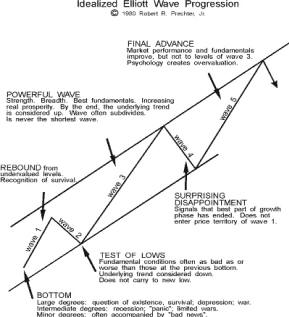The Wave Principle identifies trend, countertrend, maturity of a trend — and more.
by Editorial Staff
The following article is an excerpt from Elliott Wave International’s Trader’s Classroom Collection.
Every trader, every analyst and every technician has favorite techniques to use when trading. But where traditional technical studies fall short, the Wave Principle kicks in to show high probability price targets and, just as importantly, how to distinguish high probability trade setups from the ones that traders should ignore.
Where Technical Studies Fall Short
There are three categories of technical studies: trend-following indicators, oscillators and sentiment indicators. Trend-following indicators include moving averages, Moving Average Convergence-Divergence (MACD) and Directional Movement Index (ADX). A few of the more popular oscillators many traders use today are Stochastics, Rate-of-Change and the Commodity Channel Index (CCI). Sentiment indicators include Put-Call ratios and Commitment of Traders report data.
Technical studies like these do a good job of illuminating the way for traders, yet they each fall short for one major reason: they limit the scope of a trader’s understanding of current price action and how it relates to the overall picture of a market. For example, let’s say the MACD reading in XYZ stock is positive, indicating the trend is up. That’s useful information, but wouldn’t it be more useful if it could also help to answer these questions: Is this a new trend or an old trend? If the trend is up, how far will it go? Most technical studies simply don’t reveal pertinent information such as the maturity of a trend and a definable price target — but the Wave Principle does.
How Does the Wave Principle Improve Trading?
Here are five ways the Wave Principle improves trading:
1. Identifies Trend – The Wave Principle identifies the direction of the dominant trend. A five-wave advance identifies the overall trend as up. Conversely, a five-wave decline determines that the larger trend is down. Why is this information important? Because it is easier to trade in the direction of the overriding trend, since it is the path of least resistance and undoubtedly explains the saying, “the trend is your friend.” Simply put, the probability of a successful commodity trade is much greater if a trader is long Soybeans when the other grains are rallying.

